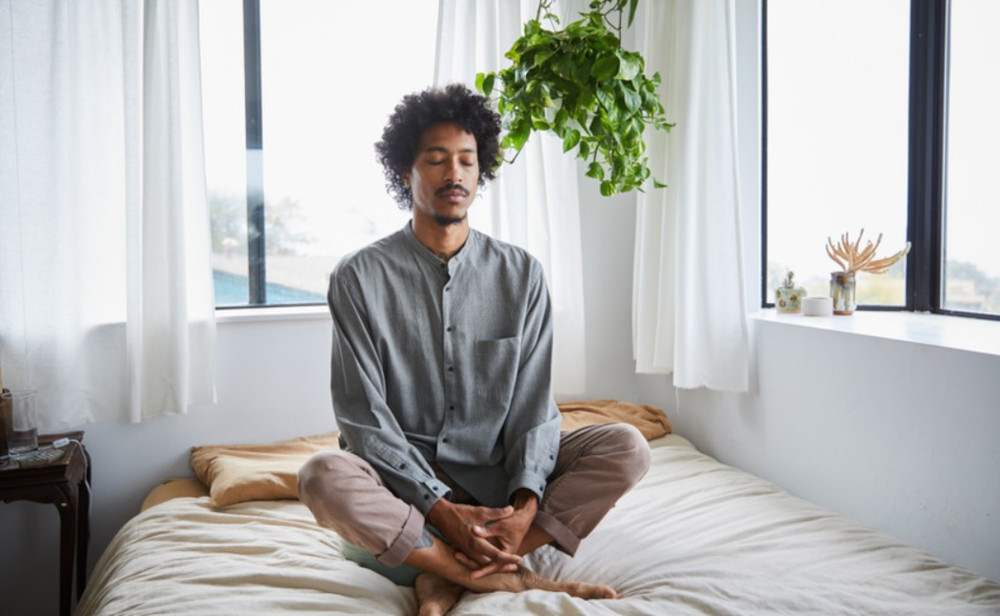By Sara Merrick-Albano, E-RYT, C-IAYT
As a medical professional, you probably see patients every day with anxiety, regardless of your specialty. Anxiety is a normal response to the stress that comes with making medical decisions, such as choosing treatment options, surgery, or medication. For patients with chronic illness, anxiety can start to interfere with daily life, and managing mental health becomes a critical part of the treatment process.
As yoga therapists, we work with clients who are suffering from anxiety brought about by chronic illness. With or without a formal diagnosis of anxiety disorder, the symptoms of anxiety can interfere with a client’s overall sense of wellbeing. Yoga therapy provides an integrative treatment option for people suffering from anxiety, either by itself or alongside chronic illness.
What is Yoga Therapy?
Yoga therapy is the targeted application of yoga techniques for specific health conditions. These techniques include yoga postures and movement, breathing techniques, meditation, chanting, and philosophy. Yoga therapy is one-on-one and yoga practices are individualized for the client. The yoga therapist takes into account physical mobility issues and disease contraindications. The yoga therapists at Yoga Therapy Associates design yoga practices for their clients using a combination of evidence-based research and clinical experience, to ensure efficacy of practices.
Yoga therapy plays a key role in integrative health care because of its ability to work with the whole person, taking into account health history, chronic illness, and current symptoms. By working with the client’s experience of their own health condition, yoga therapy can help clients manage symptoms of anxiety, whether anxiety is a disorder on its own or co-occurs with chronic illness.
How Does Yoga Therapy Help With Anxiety?
Yoga therapy is a learning process: the client learns yoga practices that they can use to manage their symptoms. These yoga practices help manage anxiety symptoms in several ways. First, they help to address nervous system dysfunction, in part by regulating breathing patterns. Second, they increase bodily awareness and interoception, teaching clients how to recognize anxiety symptoms before they become severe. Finally, they help to improve sleep quality.
Anxiety, Yogic Pranayama, and Nervous System Regulation
The autonomic nervous system is responsible for regulating the body’s response to stress. When we are stressed, our nervous system goes into sympathetic or “fight-or-flight” mode. This is a natural response that helps us to stay safe in dangerous situations. However, if we are constantly stressed, our nervous system can become dysregulated. This can lead to a number of symptoms, including anxiety.
One way to control the nervous system response is by modulating the breath. By breathing deeply and slowly, the parasympathetic nervous system gets activated. This can help to reduce anxiety, stress, and other negative emotions. Yogic pranayama (breath modulation) techniques can help clients establish a regular rate of breath by teaching the client how to breathe deeply and slowly. Deep breathing exercises can help to calm the nervous system and reduce the symptoms of anxiety.1
By learning to control their own breathing, the client also develops a sense of agency and control over their own system. This can help to improve confidence and self-esteem, which can support the client with chronic illness during their treatment process.
For a client with anxiety, it can be difficult to sit and practice deep breathing right away. Concentrating on the breath can exacerbate feelings of anxiety for some. At Yoga Therapy Associates, we often begin with teaching clients gentle movement coupled to their breath. The movements facilitate the mechanics of breathing without overwhelming the client.
Yoga Increases Interoception and Bodily Awareness
By becoming aware of internal physical sensations (interoception), the client can learn to identify and manage the physical symptoms of anxiety.2 We teach our clients techniques such as awareness of sensation in physical movement practices or meditation. Over time, the client is better able to recognize anxiety symptoms like shallow breathing, increased heart rate, nausea, and rapid thoughts. From a place of improved awareness of their internal state, the client has the confidence to use techniques like breathing and gentle movement to access the parasympathetic nervous system state and facilitate relaxation.
Yoga Therapy Can Improve Sleep
Finally, yoga can help to improve sleep. Stress and anxiety can make it difficult to fall asleep and stay asleep. Research shows that long-term patterns of disturbed sleep and insomnia increase anxiety symptoms.3 Poor sleep also impacts decision-making ability, which can be detrimental for those clients with a chronic illness who are making decisions about their medical treatment.
Yoga can help to improve sleep quality by increasing the amount of deep sleep and reducing the amount of light sleep. Deep sleep is important for physical restoration and mental health.4 For those clients with poor sleep patterns, yoga therapists work to improve nervous system regulation. We also teach clients a specific meditation technique called yoga nidra, a form of non-sleep deep rest (NSDR) that trains the body to access the state of sleep.
Helping Your Patients With Anxiety
Overall, yoga is a safe and effective way to help manage anxiety symptoms. If your patients are struggling with anxiety, consider referring them to a yoga therapist through Yoga Therapy Associates.
We offer in-person yoga therapy at four locations across Connecticut, as well as telehealth.
If you are interested in learning more about how yoga therapy can help your patients, request a meeting or contact us.
References
- Cramer, H., Anheyer, D., Saha, F. J., & Dobos, G. (2018). Yoga for posttraumatic stress disorder – a systematic review and meta-analysis. BMC psychiatry, 18(1), 72. https://doi.org/10.1186/s12888-018-1650-x
- Neukirch, N., Reid, S. C., & Shires, A. G. (2019). Yoga for PTSD and the role of interoceptive awareness: A preliminary mixed-methods case series study. European Journal of Trauma & Dissociation, 20(1), 108-119. https://doi.org/10.1016/j.ejtd.2018.10.003
- Staner L. (2003). Sleep and anxiety disorders. Dialogues in clinical neuroscience, 5(3), 249–258. https://doi.org/10.31887/DCNS.2003.5.3/lstaner
- Salfi, F., Lauriola, M., Tempesta, D., Calanna, P., Socci, V., De Gennaro, L., & Ferrara, M. (2020). Effects of Total and Partial Sleep Deprivation on Reflection Impulsivity and Risk-Taking in Deliberative Decision-Making. Nature and science of sleep, 12, 309–324. https://doi.org/10.2147/NSS.S250586




